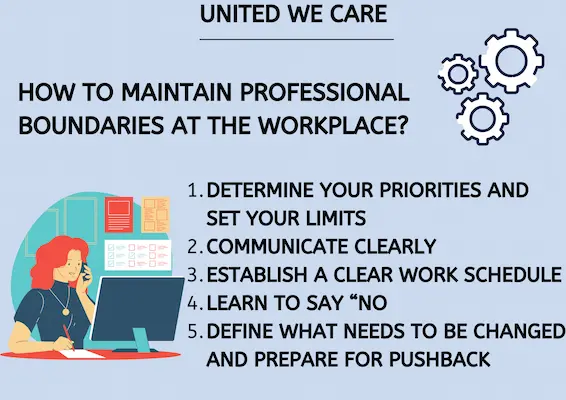Introduction
In today’s interconnected world, there is a very thin line between personal and professional life; hence, setting boundaries in the workplace plays an important role in establishing work-life balance. It helps you take care of your physical and emotional well-being. Setting professional boundaries from the start will allow you to navigate your workplace, boost your job satisfaction, and help you prevent burnout. Setting boundaries brings certainty and clarity.
Importance Of Professional Boundaries at Workplace
Increased Productivity: Feeling pressure when taking on additional tasks can contribute to lower performance and impact the quality of work. Healthy boundaries can help you focus on the tasks that align with your roles and responsibilities and you’ll be able to prioritise work efficiently and concentrate better on essential tasks which can help you be less distracted by non-essential requests.
Manage work-related stress: When you set limits to the amount of work you do, hours of work you take, and type of tasks you do, you’ll be able to manage your workload, which can help you manage burnout, and you’ll not feel overwhelmed.
Work-life balance: Often, work takes precedence over other aspects of life. Setting boundaries and limits will help you prioritize the demands of your career and your personal life. These boundaries will help you maintain a healthy equilibrium.
Foster positive interactions and create better communication: It’s easier to collaborate when boundaries are clearly defined. When colleagues respect each other’s boundaries, it leads to a harmonious environment, which gives a sense of security. Professional boundaries also affect communication with colleagues and supervisors. It helps prevent conflicts and misunderstandings.
How To Maintain Professional Boundaries at The Workplace?

Determine your priorities and set your limits: To maintain professional boundaries, it’s crucial to identify both your personal and professional priorities. It’s also important to consider the priorities of the supervisor given the job responsibilities. Acknowledging your priorities will help you determine which boundaries to set. Pay attention to the people, situations, and tasks that cause you stress and discomfort, and evaluate how important it is for your growth to be engaged in certain situations. Once you have an idea about your workload and priorities, try to set a limit to the extent to which you’re willing to extend your boundaries without compromising productivity and job responsibilities. Ensure that the boundaries you’re making are realistic and attainable.
Communicate Clearly: The better you can express your thoughts, the better your boundaries will be communicated, and you will be safeguarding against future potential miscommunications. Describe your boundaries and why they are important. Communicate with your colleagues and supervisors using “I” statements. This will show connection and demonstrate that you take responsibility for your actions. Approach the conversation in a negotiating way. Try to understand the situation from their perspective to keep the communication open. Be firm but respectful while communicating, and avoid getting defensive. Being polite and firm will help them understand why these boundaries are important to you.
Establish a clear work schedule: Remote work and flexible schedules can sometimes blur the boundaries between personal and professional life; therefore, it’s essential to establish dedicated working hours. Have open and honest discussions with your supervisors to discuss the hours for you to work to meet your goals. Define specific time slots during which you’re available for work-related tasks. This will allow you to focus better and will remind others of your availability. Schedule your other activities as well, such as taking time for self-care, activities that are important to you, and spending time with your loved ones.
Learn to say “NO”: Saying no can be uncomfortable for a lot of people. Yet, it’s important to exercise your ability to say no. Saying “No” is important for setting professional boundaries. You can turn down the request politely by helping them understand you’re already at the capacity or the request doesn’t align with the current responsibilities. Be clear and honest about your reasons.
Define what needs to be changed and prepare for pushback: When you feel your boundaries are crossed, take time to understand what needs to be changed and where you’re lacking. Gain insight into the area of concern and request politely and firmly for the changes expected. There could be times when others would react negatively to your healthy boundaries. Instead of taking it as a setback, make sure you’re handling the situation rationally rather than emotionally and taking it as an opportunity to improve your boundary settings.
Mistakes To Avoid Setting Professional Boundaries in The Workplace
Setting boundaries is not always simple. Mistakes can happen, and it’s important to be aware of them.
Over-explaining: Explaining too much or being too nice can give unclear messages, which can lead to confusion.
Setting boundaries but not consistently enforcing them: It can give the wrong message to others and can appear as if you’re not serious about your boundaries.
Setting unrealistic boundaries: It’s important to establish realistic and achievable boundaries so that it doesn’t become difficult to maintain and lead to frustration and disappointments.
Fear of confronting: Not communicating boundaries or not addressing the concerns because of fear of conflict. It’s important to communicate assertively.
Ignoring other’s boundaries: Disregarding or minimising the boundaries set by others can lead to conflicts. Respect other’s boundaries just as you expect them to respect yours. Mutual respect and awareness of one another’s boundaries are essential components of good interpersonal relationships.
Conclusion
Implementing boundaries, understanding the importance of boundaries, and avoiding the common mistakes people make while setting professional boundaries will empower you to achieve a balance between productivity and personal well-being. Employees must understand professional boundaries, communicate them clearly, and be prepared to respond appropriately when challenged. By valuing each other’s boundaries and respecting each other’s limits, you can create a positive work environment that can foster growth.
References
Malin, N. (Ed.). (2000). Professionalism, boundaries, and the workplace (pp. 17-24). London: Routledge.
Plester, B. (2009). Crossing the line: Boundaries of workplace humor and fun. Employee Relations, 31(6), 584-599










